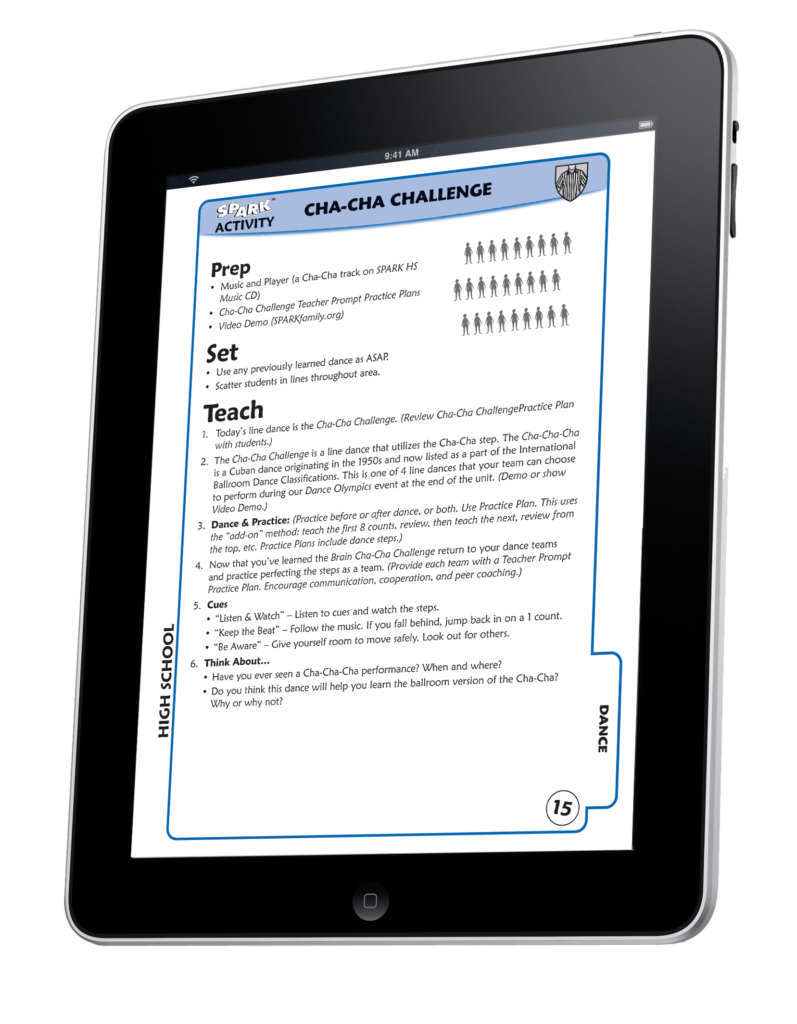PE Programs Move from Competition to Inclusion With a SPARK of Technology

By Paul Rosengard
Wow – physical education (PE) has changed! Do you remember waiting in a long line hoping to be one of the lucky few chosen by a team captain? Or painfully enduring names being called until you were finally chosen as one of the last participants?
Fortunately for all of us — today’s PE programs are not like that, that is if they are evidence-based, modeled from the latest research and designed to be more inclusive, active, and fun. Effective programs integrate the latest technology and focus on including every child in physical fitness and skill development, while instilling a love for movement that will continue through adulthood.
Take for instance a 3rd grade class playing a game called “Crazy Cones.” Students are quickly divided into two groups and stationed at various spots within a safe activity area. When the music starts, one group stands up cones – while the other group tips them over. A teacher prompts students to work on personal goals, such as standing up more cones than the last time, and they strive as a group to have the highest percentage of cones in their favor. This is a simple, yet cardio-rich activity that every child can play to the best of his or her ability. Students can wear pedometers and afterwards check their step counts. If they play again, they can try to improve their step total.
While elementary students use pedometers to monitor their activity levels during a SPARK PE class, middle and high school-level students use both pedometers and heart rate monitors. Students wearing heart rate monitors during a Dance unit record heart rate data onto a portfolio assessment worksheet. Then, using the same portfolio worksheet they record data during a Flying Disc unit. Using these data sheets, students can then analyze the exercise intensity levels of a variety of activities and make decisions on how each fits into a lifelong physical activity plan. They’ll also make an assessment of personal effort and participation.
SPARK researchers and educators believe there are four “essential components” necessary to implement a quality PE program:
- An active curriculum aligned to national and state standards (the “what” to teach)
- Effective teacher training (the “how to teach it”)
- Content-matched equipment (the “tools you need to teach it”), and
- Extensive follow-up support (because programs must institutionalize to be successful).
When it comes to providing a PE program everyone can participate in, teachers need to know how to assess students and differentiate their instruction appropriately. By focusing on improving every student’s personal level, and using appropriate equipment to do so, we foster better educational outcomes. An example of this is teaching a child to play volleyball. While it might seem that a smaller volleyball is easier and safer, having a small child bump a small ball can cause stinging and prevent them from wanting to learn the skill. Instead, a teacher might prevent this by starting young children off with balloons to learn the skill. By giving them something that moves slower and is softer, students will be able to master the skill, move on to more game-like equipment and eventually have fun playing volleyball with a regulation size ball.
Adding Technology to PE Programs
It’s a brave new fitness world! There are more gadgets and gizmos to help people become fit and/or stay fit than ever before. What our team at SPARK is especially excited about is how the technology can be used to transfer good health habits to different environments. With pedometers, heart rate monitors, and on-line tracking tools, PE teachers have the ability to extend that active PE class to the rest of the school environment, into the home, then generalize to the community.
Today, more and more teachers are looking for ways to integrate their smart phones, iPads, and other tablet devices with their physical education and health courses. There is a wealth of new downloadable “apps” that range from assessment tools and health tips to simple programs such as a digital scoreboard.
At SPARK, we’re looking at how iPads can be used by PE teachers and other activity promoters at schools. For example, all of our curriculum content is ready and optimized for iPads. That means that a teacher who may have brought a clipboard to class that held a lesson plan on a piece of paper can now access our content, including videos and interactive assessment tools, digitally on their tablet.
Also, with the cost of technology-driven sports equipment continuing to decline, it is more affordable for schools to add things like pedometers, heart rate monitors, stationary bikes, and exergaming systems into their PE programs. These tools allow for differentiation and motivate students to improve fitness levels. Instructors can use an LCD projector and an iPad to project programs on a wall and keep students engaged better than ever.

Locating Money to Expand PE Programs
Even with programs like Michelle Obama’s Let Move, school systems are still required to focus the majority of their funding on improving math and reading scores. Obesity in our country costs the medical community millions of dollars and because of this, there are many organizations that provide third party funding for increased PE. Educators can go to SPARK’s grant finder website (http://www.sparkpe.org/grants/) to find available grants for PE programs.
By adding even ten minutes of physical activity to a child’s day, we can have an impact on their long-term health benefits and instill a love for physical activity that will carry on for generations.
 Paul Rosengard is the Executive Director of the SPARK Programs of San Diego State University Research Foundation (disseminated by School Specialty, Inc.) and a former 11 year faculty member at the University of
Paul Rosengard is the Executive Director of the SPARK Programs of San Diego State University Research Foundation (disseminated by School Specialty, Inc.) and a former 11 year faculty member at the University of
California, San Diego, where he instructed future classroom and physical education teacher methods courses. Mr. Rosengard is known for his extensive work as a physical activity interventionist, having contributed
as an intervention director, consultant and trainer for a number of benchmark national studies/projects including SPARK, TAAG, M-SPAN, Pathways, PEACH, OPprA, OPI, POPI, and the myriad Nike campaigns.







0 Comments
Leave a Comment
Your email address will not be published. All fields are required.